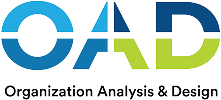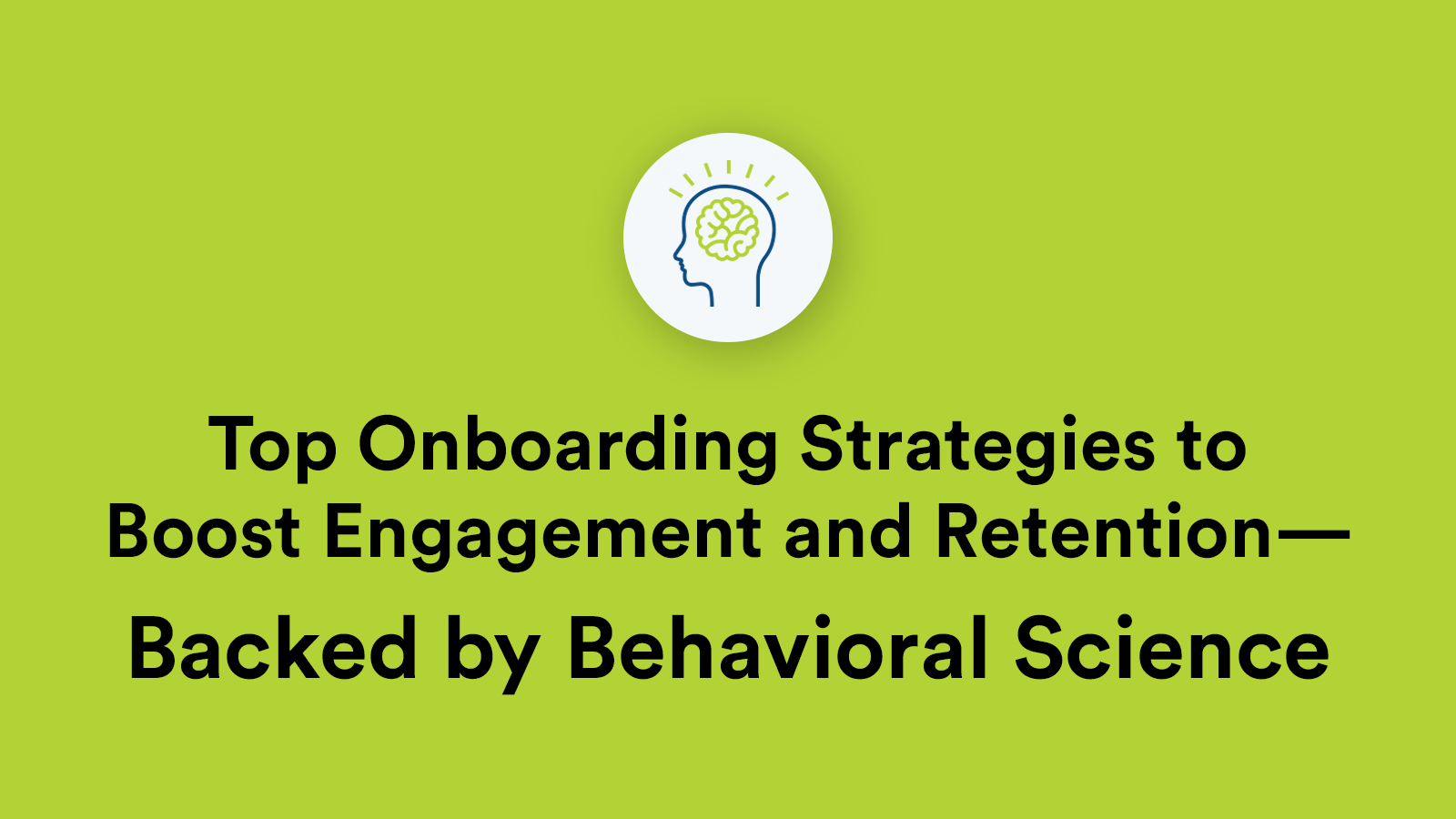A great hire can still fail if your onboarding falls short. The first 90 days are make-or-break—and without a strategic approach, even top talent can disengage, underperform, or walk away. In this guide, we’ll explore science-backed onboarding strategies that not only boost retention but create a clear path from “new hire” to high-performing team member.
Table of Contents
- Why Onboarding Strategies Fail (And What It Costs You)
- Rethinking Onboarding — From Process to Strategy
- Avoid These Common Onboarding Pitfalls Before You Scale
- Phase 1 – Pre-Boarding: Laying the Groundwork for a Seamless Start
- Phase 2 – Orientation: Building Context, Not Just Compliance
- Phase 3 – The 30-60-90 Day Plan: Structure That Drives Success
- Phase 4 – Ongoing Support: Keep Hires Engaged Long After Day 90
- The Role of Technology in Onboarding: Tools That Make or Break the Experience
- Using Behavioral Data to Personalize the Onboarding Experience
- Metrics That Matter — How to Measure Onboarding Success
- Final Thoughts — From Orientation to Integration
- Want to Improve Your Onboarding Strategy?
Why Onboarding Strategies Fail (And What It Costs You)
Even the most capable new hires can quickly become disillusioned if onboarding feels chaotic, overwhelming, or irrelevant. Many companies rush through the process—bombarding employees with paperwork, tools, and disjointed information—without offering context or support. Completing paperwork should be a structured step in onboarding, ensuring all necessary administrative tasks are finished for a smooth transition, rather than just an administrative hurdle. What they miss is that onboarding isn’t just orientation; it’s the foundation for long-term engagement, satisfaction, and performance. Onboarding activities should also reinforce the company’s culture and values, helping new employees align with organizational expectations from day one.
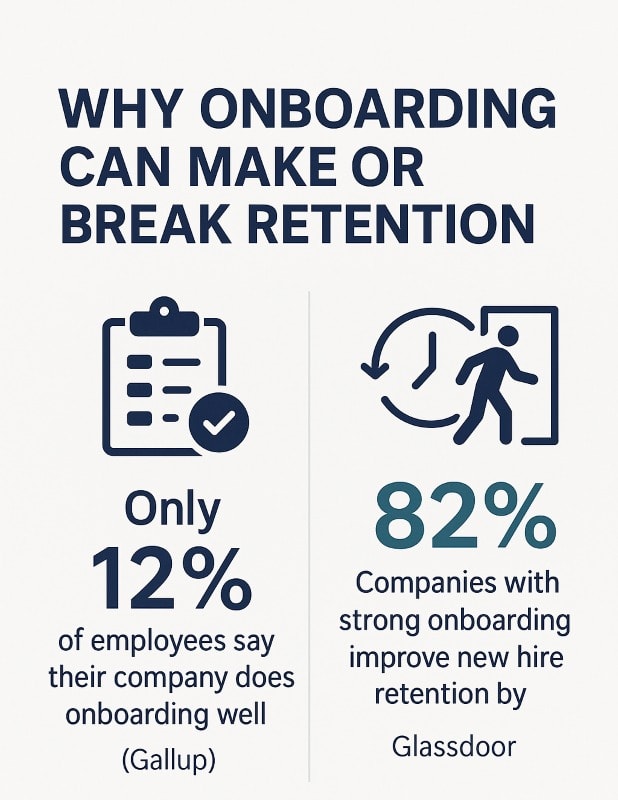
According to Gallup, only 12% of employees strongly agree that their organization does a great job onboarding new team members. That leaves a staggering 88% of the workforce at risk of starting their job disengaged. The consequences? Lower productivity, faster turnover, and higher recruitment costs—all of which ripple through your team’s morale and your company’s bottom line.
Instead of viewing onboarding as a checklist, leading organizations are now treating it as a strategic process with measurable outcomes. A company’s commitment, especially demonstrated by senior leaders, signals dedication to employee engagement, trust-building, and a strong company culture. Because when onboarding fails, you’re not just losing time—you’re losing people.
Rethinking Onboarding — From Process to Strategy
It’s easy to confuse onboarding with paperwork, software logins, and team introductions. But effective onboarding is not just a process—it’s a strategy. An effective onboarding strategy is a well-designed, comprehensive approach that integrates new hires into the organization, positively impacting long-term retention and employer branding. And like any good strategy, it should be intentional, data-informed, and aligned with your business goals.
Think about how Jeff Bezos famously left an empty chair in meetings to represent the customer. What if companies took a similar approach during onboarding—designing the experience around the employee’s perspective rather than internal checklists? A comprehensive employee onboarding strategy should also integrate cultural alignment and provide opportunities for professional growth, ensuring new hires feel connected and supported from day one. When new hires are overwhelmed with tools and tasks, the message isn’t “We value you.” It’s “Get up to speed—or get left behind.”
Behavioral science offers a better path. Studies show that humans retain information far better through spaced learning than through one-time information dumps. That’s why strategic onboarding spreads out essential knowledge, feedback, and cultural alignment over time—so employees can absorb, apply, and grow. An effective onboarding process is crucial for improving retention and reducing turnover costs, making it a key factor in organizational success. The goal isn’t just faster productivity—it’s deeper engagement and longer-term retention.
A well-designed onboarding process also enhances the overall employee experience, leading to higher satisfaction and engagement.

Integrating onboarding strategies into the hiring process is essential for ensuring a seamless transition for new employees.
Avoid These Common Onboarding Pitfalls Before You Scale
Even well-intentioned onboarding programs can fall short—especially when they lack structure, follow-through, or alignment with business goals. One of the most common mistakes? Launching new employees into their roles without a strategic onboarding plan. Without clear direction, new hires often feel overwhelmed by essential tasks, disconnected from their team members, and unsure how to succeed. The result? Lower employee engagement and slower time-to-productivity.
Another common misstep is treating onboarding as a one-time event instead of a phased journey. Without ongoing support, regular manager check-ins, and access to relevant training, new hires may struggle to adapt—leading to frustration, stalled development, and higher turnover.
To avoid these pitfalls, organizations should design a comprehensive onboarding strategy with clear milestones, tailored employee introductions, and a structured roadmap of the first 90 days. Most importantly, don’t guess—gather feedback from new employees throughout the onboarding period to identify bottlenecks and opportunities for improvement. By addressing these missteps proactively, HR professionals and hiring managers can deliver an onboarding experience that builds confidence, fosters connection, and supports long-term success.
Phase 1 – Pre-Boarding: Laying the Groundwork for a Seamless Start
Before a new hire even walks through the door (physically or virtually), their experience with your company has already begun. Pre-boarding is your opportunity to create a smooth transition from offer acceptance to day one—and it’s often the most overlooked phase of onboarding. By integrating pre-boarding into your process, you ensure a seamless transition from the hiring process to the new job, helping new hires feel supported from the start.
Done right, it reduces first-day anxiety, increases early engagement, and signals that your organization is thoughtful and prepared. Pre-boarding also helps new hires prepare for their new job by providing essential resources and information, which reduces stress and helps them feel more confident.
Involving current employees in pre-boarding activities can foster early integration and open communication between new hires and the existing team.
Personalized Welcome Messages That Set the Tone
A templated “we’re excited to have you” email isn’t enough. Send a personalized welcome message from the hiring manager or a senior leader that connects your company’s vision to the new hire’s specific role. Bonus: include a short video or voice message to add a human touch. These small gestures can significantly enhance the employee’s onboarding experience and reinforce your employer brand. A personalized approach from the hiring manager helps improve the employee’s onboarding experience by fostering early engagement and building trust from day one.
Access to Essential Tools and Communication Platforms
No one wants to spend their first morning waiting for system logins. Provide early access to essential platforms like your intranet, HR portal, and communication tools. Make sure new hires can access payroll details and complete any necessary paperwork before their first day. Include a quick-start guide or a “What to Expect on Day One” checklist. This helps new team members feel empowered and ready, not reactive.
Assigning Peer Mentors for Early Relationship Building

Assigning a peer mentor or onboarding buddy can bridge the gap between “new person” and “team member.” It gives new hires someone they can turn to for informal questions and helps them build meaningful relationships with other team members before they even start. This approach supports employees as they build meaningful relationships and integrate more smoothly into the organization. It’s also a smart way to reinforce your company culture and encourage cross-team connection. Including team building activities during pre-boarding further fosters collaboration, helps new hires engage with other team members, and sets the stage for a supportive environment.
Phase 2 – Orientation: Building Context, Not Just Compliance
Orientation is often treated as a box to check—hand over the employee handbook, introduce a few team members, and hope the new hire finds their footing. But for companies serious about employee engagement and long-term retention, orientation is more than an administrative task. It’s your chance to connect the dots between company values, team culture, and the individual’s purpose in their new role. Orientation activities also help new hires understand and connect with the organization’s culture, making it easier for them to align with shared values and expectations.
Make Company Culture Tangible on Day One
Culture can’t be explained—it has to be experienced. Use orientation to create immersive moments that reflect your organization’s values in action. This might mean a casual team lunch, a story from a senior leader about a culture-defining moment, or even a short walkthrough of how decisions get made. The goal is to make the company’s DNA visible and relatable.
Introductions That Facilitate Meaningful Connections

Generic roundtables don’t build relationships. Instead, curate introductions based on likely collaboration points—have the new hire meet cross-functional partners, not just their immediate team. Assign a “tour guide” for the day to show them not just where things are, but how things work. These small tweaks accelerate social belonging and reduce early friction.
Strategic Use of Employee Handbooks and Admin Tools
Completing paperwork is a crucial part of the user onboarding process, but timing is everything. Rather than front-loading all administrative tasks, structure the user onboarding process by spreading out completing paperwork and other tasks across the first week using onboarding software or a task-tracking system. This approach ensures new hires stay focused and aren’t overwhelmed by documents. Include context for why each policy matters to their role and the company’s mission—it helps connect compliance with purpose.
Phase 3 – The 30-60-90 Day Plan: Structure That Drives Success
The first three months are a proving ground—not just for your new hire, but for your onboarding strategy. A well-structured 30-60-90 day plan transforms ambiguity into action by giving new employees clear goals, support systems, and feedback loops. It also helps hiring managers track progress and course-correct early, before small issues become costly exits. The HR team plays a crucial role in supporting the onboarding process, coordinating with managers, and collecting onboarding data to monitor employee integration.
Human resources can leverage onboarding data to refine and improve onboarding strategies, ensuring better outcomes for both employees and the organization.
Setting Clear Milestones and Metrics for Growth
People thrive when they know what’s expected—and how success will be measured. Break down key outcomes for each onboarding phase:
- 30 days: Learn the systems, build relationships, understand the company mission
- 60 days: Take ownership of core tasks, engage in problem-solving, contribute to meetings
- 90 days: Deliver independent work, suggest improvements, align with team goals
When these goals are tied to strategic business objectives, new hires feel a deeper sense of purpose and impact.
Continuous Check-Ins With Direct Managers
Too many onboarding plans fail because feedback is delayed or inconsistent. Schedule recurring one-on-ones during the first 90 days to clarify expectations, address roadblocks, and build trust. Managers should also provide context—not just what to do, but why it matters. This type of structured manager involvement has been linked to higher job satisfaction and stronger retention.
Introduce Development Early to Boost Engagement
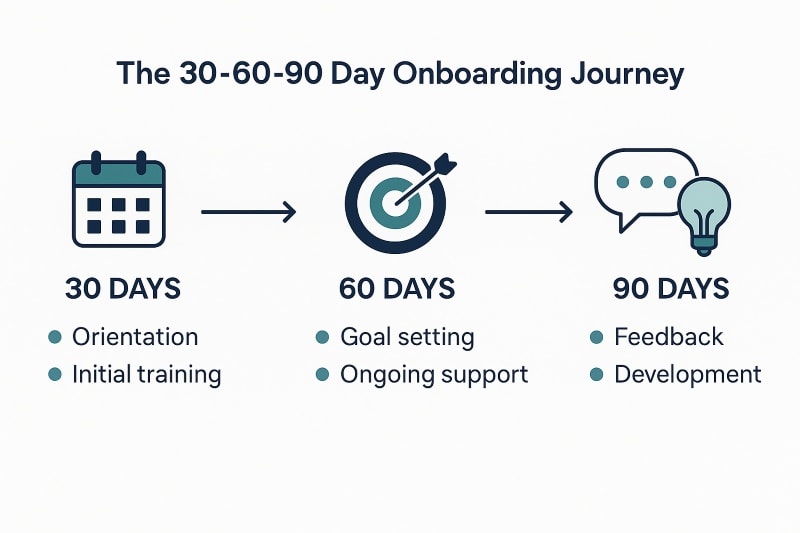
Professional growth shouldn’t be postponed until performance reviews. Introduce development conversations within the first 60 days—whether it’s access to online learning platforms, mentorship programs, or stretch assignments. Early exposure to growth opportunities signals long-term investment and builds intrinsic motivation.
This is where tools like OAD’s psychological survey can give your managers a head start. With early insight into a new hire’s communication style, decision-making preferences, and motivators, managers can personalize support and feedback right from week one.
Phase 4 – Ongoing Support: Keep Hires Engaged Long After Day 90
Successful onboarding doesn’t end at the three-month mark. If anything, this is when the real work begins. After the initial ramp-up, new hires need ongoing support to stay engaged, grow in their roles, and contribute meaningfully to your organization’s goals.
The support team plays a crucial role in this phase by providing resources, documentation, and assistance to help new hires continue integrating smoothly.
Without it, even high-potential employees can plateau—or leave.
Turn Feedback Loops Into Growth Engines
Establish a consistent rhythm of feedback—not just from managers, but across peers and stakeholders. Use performance check-ins to identify what’s working, what needs adjustment, and where the employee wants to grow. More importantly, close the loop by acting on that feedback. When employees feel heard and supported, loyalty follows.
Foster a Culture of Learning and Upskilling
Top performers crave growth. Offering access to continuous learning—online courses, lunch-and-learns, certifications, or peer coaching—keeps your team future-ready. Consider linking learning opportunities to OAD-based behavioral profiles, so development tracks align with individual strengths and learning styles. Personalized growth pathways are far more effective than generic training.
Recognize Contributions (Even the Small Ones)

Recognition is a low-cost, high-impact tool for long-term engagement. Don’t wait for annual reviews to acknowledge impact. Celebrate early wins, problem-solving moments, and culture-building behaviors. A shout-out from a senior leader or a peer-nominated kudos can reinforce a new hire’s sense of belonging and value.
The Role of Technology in Onboarding: Tools That Make or Break the Experience
In today’s dynamic work environment, technology isn’t just helpful in onboarding—it’s foundational. The right onboarding software can automate routine tasks, streamline communication, and ensure consistency across the entire onboarding journey. More importantly, it frees up your HR team to focus on what matters most: building meaningful relationships and setting up new hires for long-term success.
From personalized welcome messages to automated onboarding checklists, software solutions help eliminate friction in the early days—ensuring no critical step falls through the cracks. At the same time, communication tools like Slack or Zoom play a vital role in helping new hires build connections with team members, especially in remote or hybrid settings. The easier it is to ask questions and engage with colleagues, the faster new employees become integrated contributors.
Well-designed platforms also embed onboarding best practices directly into the workflow—guiding both new employees and managers through essential steps while reducing the risk of overload. Combined with behavioral insights, these tools can even adapt onboarding flows based on how a person prefers to learn, communicate, and receive feedback.
When used intentionally, technology doesn’t just support onboarding—it elevates it.
Using Behavioral Data to Personalize the Onboarding Experience
No two employees are alike—so why should their onboarding be? Personalizing the onboarding journey based on how someone thinks, communicates, and makes decisions leads to faster integration, stronger performance, and better cultural alignment. That’s where behavioral data comes in.
Companies like Amazon and Netflix have long used data to personalize customer experiences. Forward-thinking HR leaders are now applying the same logic to onboarding. When you understand a new hire’s behavioral tendencies, you can tailor everything from communication cadence to task delegation and support structure. This tailored approach keeps users engaged throughout the onboarding process, which improves retention and reduces drop-off rates.
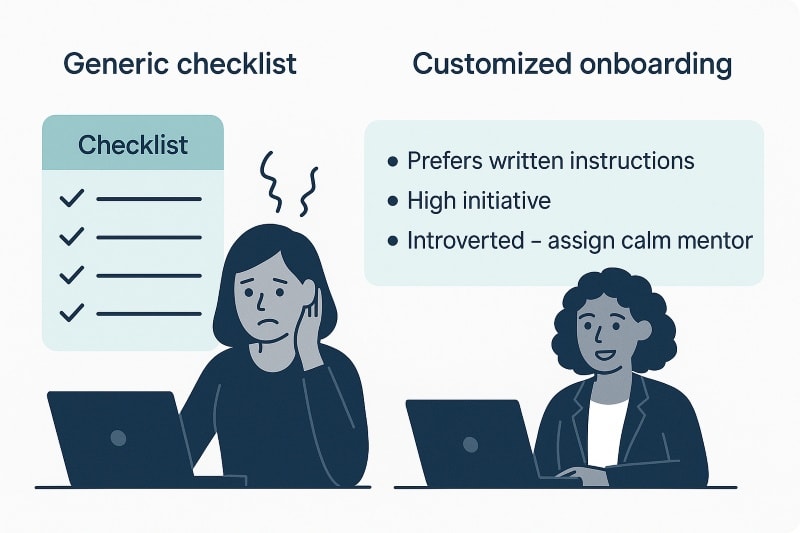
That’s exactly what OAD’s scientifically validated psychological survey provides. It offers deep insight into a new hire’s work style, motivators, and preferred communication methods—within minutes. Armed with this data, hiring managers and HR professionals can design onboarding experiences that feel natural, empowering, and aligned with the employee’s strengths.
Imagine assigning a mentor whose behavioral traits complement the new hire’s style. Or adjusting the onboarding pace for someone who thrives on independence versus collaboration. These aren’t just nice-to-haves—they’re what differentiate good onboarding from great onboarding.
When employees feel understood from day one, they’re more likely to stay, grow, and contribute meaningfully. That’s the real ROI of behavioral personalization.
Why Strategic Onboarding Drives Company Performance
Onboarding isn’t just about getting new hires settled—it’s a high-leverage business strategy that directly impacts performance, retention, and growth. When companies invest in a well-designed onboarding program, they don’t just improve the employee experience—they see measurable gains in productivity, engagement, and long-term retention.
New hires who go through a structured, supportive onboarding are more likely to align with your organizational goals, deliver quality work faster, and strengthen your company culture. They also report higher job satisfaction, which translates into lower turnover and stronger team dynamics.
But the impact doesn’t stop with employees. An effective customer onboarding process ensures that new users quickly understand your product or service, accelerating user activation and improving the overall customer experience. Familiar, supported customers are more likely to stay loyal, refer others, and expand their usage—directly increasing customer success and lifetime value.
By tracking key onboarding metrics—such as time-to-productivity, employee satisfaction, and retention—companies can optimize their onboarding strategy over time. The result? A smarter, more scalable organization with both a high-performing workforce and a loyal customer base.
Strategic onboarding doesn’t just reduce friction. It creates momentum—internally and externally.
Metrics That Matter — How to Measure Onboarding Success
If you can’t measure it, you can’t improve it. For too long, onboarding has been viewed as a soft function—but the most effective HR teams treat it like any other business process: outcome-driven and backed by data.
Strategic onboarding doesn’t just feel better—it performs better. You just have to know what to measure.
Key Onboarding Metrics to Track
Not every metric is created equal. Here are the ones that actually reflect onboarding effectiveness:
- New hire retention rate (30-, 60-, 90-day marks)
- Time to productivity
- Employee satisfaction with onboarding experience
- Engagement scores in the first 90 days
- Manager satisfaction with new hire performance and fit
Tracking these over time allows HR professionals to spot trends, identify friction points, and refine the onboarding journey for future hires.
Gather Feedback Early and Often
Employee feedback is one of the most valuable onboarding tools you have—if you ask the right questions. Short pulse surveys at the end of week one, day 30, and day 90 can surface issues before they escalate. Focus on clarity, support, and cultural alignment. Bonus: include open-text questions for qualitative insights that data alone can’t provide.
Make Data Actionable With the Right Tools

It’s not just about collecting data—it’s about activating it. Use onboarding software to automate surveys and track progress. Pair it with OAD’s behavioral insights to spot patterns in success or attrition across different personality profiles. For example, are high-autonomy profiles churning faster in team-heavy roles? These are signals worth listening to.
Final Thoughts — From Orientation to Integration
Onboarding isn’t a single event. It’s a strategic journey that, when done right, turns promising hires into loyal high performers. From pre-boarding to 90-day planning to long-term support, each phase should reflect your organization’s values, your leadership standards, and your commitment to employee growth.
The best onboarding strategies don’t just hand over tools—they build trust. They don’t just communicate expectations—they create alignment. And they don’t just reduce churn—they shape culture. Creating a positive first impression for new hires is essential, as it enhances your employer brand and sets the tone for how new employees and even potential candidates perceive your organization.

When you personalize the onboarding experience with behavioral data, empower managers with actionable insights, and track what truly matters, you do more than integrate a new hire—you build the foundation for long-term success.
Want to Improve Your Onboarding Strategy?
If your current onboarding process feels more reactive than strategic, now is the time to rethink it.
OAD helps HR professionals and hiring managers design onboarding journeys rooted in behavioral science—so you can build stronger teams, faster. Our psychological survey gives you deep insight into how each new hire thinks, communicates, and thrives—allowing you to personalize onboarding from day one.
OAD can also enhance the customer onboarding experience by helping new users become familiarized with your products and supporting user activation through targeted onboarding strategies. Customer success teams can collaborate with HR and support to ensure a seamless onboarding process for both employees and customers, improving satisfaction and retention.
Whether you’re scaling fast or simply want to improve retention, we’ll help you align your onboarding strategy with what actually works.
